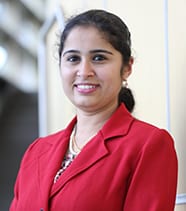
This project will positively impact family farms and the middle-class system of rural America.
– Sruthi Narayanan, Clemson crop ecophysiologist
Just as family members nurture one another, certain crops can aid each other when planted together.
Growing two or more crops close to each another is a practice known as intercropping. Long ago, the Cherokee and Iroquois Indians discovered benefits of planting beans, corn and squash together to develop a central food system. Each crop offers something vital to the other two crops. Beans absorb nitrogen from the air and convert it to nitrates, fertilizing the soil for corn and squash. In return, beans are supported by winding around the corn stalks. Squash leaves provide ground cover between the corn and beans, preventing weeds from taking over the field. These three plants thrive together better as companions than when they are planted alone.
Clemson researcher Sruthi Narayanan is taking this idea of intercropping, or companion crop production, and applying it to a study involving interseeding cover crops with organic corn, a cash crop. Interseeding and intercropping are basically the same principle, but when cover crops are grown with cash crops, the term “interseeding” is used.

“Sometimes looking to the past for answers to current issues is meaningful,” said Narayanan, a crop ecophysiologist in the Clemson Department of Plant and Environmental Sciences, who is leading this study funded by the United States Department of Agriculture Sustainable Agriculture Research and Education program. “Intercropping was used in ancient times to create mutually beneficial ecosystems and functionally diverse plant communities to increase individual plant production. Our project involves interseeding a cover crop into a corn crop to improve soil-plant interactions, reduce resource inputs, improve cropping system productivity and more.”
For this study, researchers will compare cover crops – buckwheat, clovers and peas (field peas and cowpeas) – interseeded in an organic corn crop. These comparisons will include the cover crops planted in tilled and no-tilled situations using standard, low and high seeding rates.
These cover crops were selected because they pose very little competition with companion cash crops while enhancing microbial communities, nutrient cycling, natural pest control and bio-drilling benefits in Southern soils. The researchers say this will enhance biodiversity and ecosystem services, as well as improve soil health and sustainability in organic grain production systems resulting in healthy environments which could lead to healthy farmers, ranchers and livestock, ultimately resulting in healthy communities.
Reduced tillage and mechanical cultivation will reduce soil erosion and reduced use of inputs will help reduced leakage/seepage of farm-inputs to groundwater or other water bodies, providing a safer environment for people to live in. Reduced input use also lessens the possibility of exposure to pesticides and other potentially harmful crop inputs.
This project involves researchers from a variety of disciplines at Clemson University, South Carolina State University, Temple University and the University of Georgia, who will approach the study from different angles to ensure more people will benefit.

One researcher is Rongzhong Ye, a Clemson soil scientist stationed at the Pee Dee Research and Education Center (REC). Ye is studying soil nitrogen dynamics and microbial communities associated with nitrogen cycling. Nitrogen is important for plant growth (structure), plant food processing (metabolism) and creation of chlorophyll. Without enough nitrogen, plants cannot grow taller, or produce enough food.
“This will benefit South Carolina farmers by providing an understanding of the distribution, transformation and fate of agricultural nutrients in organic production,” Ye said. “It will benefit the environment by reducing nitrogen loss from leachates (liquid contaminants) and greenhouse gas emissions to increase nitrogen use efficiency.”
David Lamie, Clemson Extension agribusiness and rural development specialist housed at the Sandhill REC, will provide economic analyses of the project in addition to helping with outreach programs.

To help determine how interseeding can help improve farmers’ lives, the project team also includes diversified and underserved farmers, including women and family farmers.
“This project will positively impact family farms and the middle-class system of rural America rather than the industrial agricultural system,” Narayanan said. “We have a number of planned outreach activities to help educate groups about what we find during our study. Project outcomes will help improve the quality of life for producers, communities and consumers.”
Other team members from Clemson are Christopher Talley, Diana Vossbrinck and Matthew Smith. In addition to Clemson researchers, this project also includes researchers from other universities and associations including Carmen Blubaugh from the University of Georgia, Meghnaa Tallapragada from Temple University and Josh Idassi from South Carolina State University. James Matson from Matson Consulting is the external evaluator.
Additional team members include Sarah Seehaver from the Southern Cover Crops Council, Edward Hunt from the University of North Carolina at Pembroke, Kristie Wendelberger from the Southeast Organic Center at Rodale Institute, Mark Dempsey with Carolina Farm Stewardship Association, Gordon Mikell from USDA/NRCS and Mary Cromley from the South Carolina Corn and Soybean Association.
The study is expected to continue through March 2025.
-END-
Get in touch and we will connect you with the author or another expert.
Or email us at news@clemson.edu
